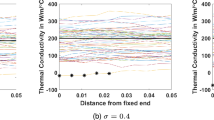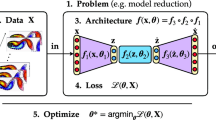Abstract
Natural convection condensation, with the advantage of high reliability and not requiring complex mechanical drive structures, is broadly used in industrial fields, such as chemical, nuclear power, automotive, etc. This work aims to investigate the heat transfer mechanism and evaluate the performance of natural convection condensation with the artificial neural network (ANN) method, correlation predictions, and the code based on the boundary theory. An empirical correlation was proposed based on the present experimental data with operating conditions in the pressure range of 0.2 MPa -0.6 MPa, subcooled temperature range of 11 K–45 K, and air mass fraction range of 0.0049–0.69. The empirical correlation was validated against a consolidated database, with 91% of the data reproduction falling within the error band of \(\pm\) 30%. An ANN model was put forward with training, validation, and testing using the present experimental data, which yields an error of \(\pm\) 5% in the present test data. When the trained model was utilized to reproduce the additional database, all the data fell within an \(\pm\) 11% error band. Finally, a side-by-side comparison in heat transfer coefficient reproduction was conducted among those rapidly computational methods, and the ANN model turned out to have the best performance.













Similar content being viewed by others
Data availability
Data will be available when someone request.
Abbreviations
- A :
-
Surface [m2]
- d :
-
Diameter [m]
- D :
-
Diffusion coefficient [m2·s−1]
- h :
-
Heat Transfer Coefficient [Wm−2·K−1]
- \({{h}}_{{fg}}\) :
-
Latent Heat [kJ·kg−1]
- l :
-
Length [m]
- m :
-
Mass [kg]
- \(\stackrel{\cdot }{{{m}}}\) :
-
Condensate mass flux [kg·s−1]
- M :
-
Molar mass [g·mol−1]
- P :
-
Pressure [Pa]
- R 2 :
-
Determination coefficient
- T :
-
Temperature [K]
- W :
-
Mass Fraction [-]
- ANN:
-
Artificial neural networks
- MAE:
-
Mean Absolute Error
- MPAE:
-
Mean absolute percentage error
- MSE:
-
Mean Square Error
- RMSE:
-
Root mean square error
- \(\rho\) :
-
Density [kg·m−3]
- \(\varphi\) :
-
Ratio [-]
- \(\mu\) :
-
Dynamic viscosity [Pa·s]
- air :
-
Air
- b :
-
Bulk
- c on :
-
Condensate
- c o :
-
Cooling Water
- e xp :
-
Experiment
- f :
-
Flow
- i :
-
Counting variable
- in :
-
Inlet
- m :
-
Mass
- o ut :
-
Outlet
- s :
-
Steam
- w :
-
Wall
References
Dehbi A (1991) The effects of noncondensable gases on steam condensation under turbulent natural convection conditions. Massachusetts Institute of Technology
Su J, Sun Z, Ding M, Fan G (2014) Analysis of experiments for the effect of noncondensable gases on steam condensation over a vertical tube external surface under low wall subcooling. Nucl Eng Des 278:644–650. https://doi.org/10.1016/j.nucengdes.2014.07.022
Fan G, Tong P, Sun Z, Chen Y (2018) Development of a new empirical correlation for steam condensation rates in the presence of air outside vertical smooth tube. Ann Nucl Energy 113:139–146. https://doi.org/10.1016/j.anucene.2017.11.021
Tan B, Wang X, Wu YW, Tian WX, Qiu SZ, Su GH (2021) Vapor condensation with low air mass fraction inside water seal branch tube under free convection. Nucl Eng Des 379:111264. https://doi.org/10.1016/j.nucengdes.2021.111264
De la Rosa JC, Escrivá A, Herranz LE, Cicero T, Muñoz-Cobo JL (2009) Review on condensation on the containment structures. Prog Nucl Energy 51:32–66. https://doi.org/10.1016/j.pnucene.2008.01.003
Dehbi A (2015) A generalized correlation for steam condensation rates in the presence of air under turbulent free convection. Int J Heat Mass Transf 86:1–15. https://doi.org/10.1016/j.ijheatmasstransfer.2015.02.034
Swartz MM, Yao S-C (2017) Experimental study of turbulent natural-convective condensation on a vertical wall with smooth and wavy film interface. Int J Heat Mass Transf 113:943–960. https://doi.org/10.1016/j.ijheatmasstransfer.2017.04.076
Dehbi A (2016) A unified correlation for steam condensation rates in the presence of air-helium mixtures under naturally driven flows. Nucl Eng Des 300:601–609. https://doi.org/10.1016/j.nucengdes.2016.02.009
Dehbi A (2020) Correcting for tube curvature effects on condensation in the presence of a noncondensable gas in laminar regimes. Int J Heat Mass Transf 151:119384. https://doi.org/10.1016/j.ijheatmasstransfer.2020.119384
Balcilar M, Dalkilic AS, Wongwises S (2011) Artificial neural network techniques for the determination of condensation heat transfer characteristics during downward annular fl ow of R134a inside a vertical smooth tube. Int Commun Heat Mass Transf 38:75–84. https://doi.org/10.1016/j.icheatmasstransfer.2010.10.009
Ewim DRE, Adelaja AO, Onyiriuka EJ, Meyer JP, Huan Z (2020) Modelling of heat transfer coefficients during condensation inside an enhanced inclined tube. J Therm Anal Calorim. https://doi.org/10.1007/s10973-020-09930-2
Abadi SMANR, Mehrabi M, Meyer JP (2018) Prediction and optimization of condensation heat transfer coefficients and pressure drops of R134a inside an inclined smooth tube. Int J Heat Mass Transf 124:953–966. https://doi.org/10.1016/j.ijheatmasstransfer.2018.04.027
Azizi S, Ahmadloo E (2016) Prediction of heat transfer coefficient during condensation of R134a in inclined tubes using artificial neural network. Appl Therm Eng 106:203–210. https://doi.org/10.1016/j.applthermaleng.2016.05.189
Ju E, Lee J, Park S, Park C, Yeo M (2019) Comparison of grey-box model and artificial neural network–prediction of surface condensation in residential space. IOP Conf Ser Mater Sci Eng (IOP Publishing) 609:032016. https://doi.org/10.1088/1757-899X/609/3/032016
Moffat RJ (1988) Describing the uncertainties in experimental results. Exp Thermal Fluid Sci 1:3–17. https://doi.org/10.1016/0894-1777(88)90043-X
Anderson MH, Herranz LE, Corradini ML (1998) Experimental analysis of heat transfer within the AP600 containment under postulated accident conditions. Nucl Eng Des 185:153–172. https://doi.org/10.1016/S0029-5493(98)00232-5
Hwang JH, Jerng DW (2021) An improved heat transfer model for steam-air mixture condensation with the curvature effect on vertical tubes. Int Commun Heat Mass Transf 123:105218. https://doi.org/10.1016/j.icheatmasstransfer.2021.105218
Park IW, Yang SH, Lee Y-G (2021) Effect of light gas on condensation heat transfer of steam–air mixture and gas stratification. Int Commun Heat Mass Transf 179:121716. https://doi.org/10.1016/j.ijheatmasstransfer.2021.121716
Funding
This work is funded by the Guangdong Basic and Applied Basic Research Foundation (Grant No. 2021A1515110604, 2022A1515012075), China Postdoctoral Science Foundation (Grant No. 2021M691058).
Author information
Authors and Affiliations
Contributions
Bing Tan: Wrote the main manuscript text Jiejin Cai: Conceptualization, Investigation, Supervision, review & editing.
Corresponding author
Ethics declarations
Competing interests
The authors declare no competing interests.
Additional information
Publisher's Note
Springer Nature remains neutral with regard to jurisdictional claims in published maps and institutional affiliations.
Appendix
Appendix
A generalized correlation was put forward by Dehbi [6], as Eq. (13), this correlation is highly recognized and widely cited, such as in the work of Swartz and Yao [7], Hwang and Jerng [17] and Park et al. [18], etc. The previously mentioned database is used to validate, as well, the error of the reproduction is shown in Fig. 14.
Rights and permissions
Springer Nature or its licensor (e.g. a society or other partner) holds exclusive rights to this article under a publishing agreement with the author(s) or other rightsholder(s); author self-archiving of the accepted manuscript version of this article is solely governed by the terms of such publishing agreement and applicable law.
About this article
Cite this article
Tan, B., Cai, J. Numerical and experimental research on natural convection condensation heat transfer. Heat Mass Transfer 60, 751–764 (2024). https://doi.org/10.1007/s00231-024-03468-x
Received:
Accepted:
Published:
Issue Date:
DOI: https://doi.org/10.1007/s00231-024-03468-x





